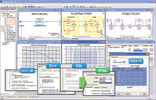

Agilent Technologies announced a new release of SystemVue, the company’s premier platform for designing communications systems. SystemVue 2012.06 provides deeper design-flow integration of baseband signal processing tools with intellectual property reference libraries, RF electronic design automation tools and test equipment.
The software enables system architects to predict and cross-verify baseband and RF physical layer performance at earlier phases of the design process, enabling faster deployment of 4G, WLAN and aerospace/defence systems. The latest release improves the design flow for new communications systems by creating an effective platform for cross-domain debugging.
By bringing target-specific FPGA tools up to the physical layer of the system, HDL designers can validate against accurate RF models and live test and measurement results, for cross-domain modelling. New SystemVue 2012.06 enhancements for baseband modellers include:
* A native math language (.m) debugger that enables line-by-line execution with breakpoints and assertions across multiple model objects, while preserving the underlying MATLAB .m format.
* C++ modelling with Microsoft Visual C++ 2010 (W1718 C++ Code Generator supports interactive cross-platform debugging, code generation and system-level verification.)
* VHDL/Verilog verification that adds Aldec Riviera PRO HDL co-simulation.
* Direct FPGA flow support for Altera Stratix and Cyclone parts, through integration of Altera Quartus with SystemVue’s W1717 Hardware Design Kit (SystemVue now supports vendor-neutral HDL code generation that integrates directly with both Xilinx and Altera tools).
SystemVue 2012.06 also features updates to several libraries and design personalities as main-tenance upgrades. The impacted solutions include:
* W1905 Radar library, now featuring multi-targeting to synthetic aperture radars.
* W1716 Digital Pre-Distortion, with added speed and user-interface improvements.
* W1916 3G library, now with support for dual-carrier HSPA+.
* W1917 WLAN library, now with legacy support for 802.11b/g/n to 802.11a/ac.
* W1918 LTE-Advanced library, now with support for multimedia broadcasting (MBMS) and control-channel (CCH) decoding.
* W1713 SerDes library, now with optical interconnect models.
* W1461 SystemVue platform, now with Monte Carlo and optimisation analysis modes, and additional examples for satellite applications.
For more information contact Clinton Hennessey, RF Design, +27 (0)21 555 8400, [email protected], www.rfdesign.co.za
| Tel: | +27 21 555 8400 |
| Email: | [email protected] |
| www: | www.rfdesign.co.za |
| Articles: | More information and articles about RF Design |

© Technews Publishing (Pty) Ltd | All Rights Reserved